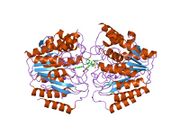Biology:HDAC8
 Generic protein structure example |
Histone deacetylase 8 is an enzyme that in humans is encoded by the HDAC8 gene.[1][2][3]
Function
Histones play a critical role in transcriptional regulation, cell cycle progression, and developmental events. Histone acetylation / deacetylation alters chromosome structure and affects transcription factor access to DNA. The protein encoded by this gene belongs to class I of the histone deacetylase/acuc/apha family. It has histone deacetylase activity and represses transcription when tethered to a promoter.[3]
Histone deacetylase 8 is involved in skull morphogenesis[4] and metabolic control of the ERR-alpha / PGC1-alpha transcriptional complex.[5]
Clinical significance
HDAC8 has been linked to number of disease states notably to acute myeloid leukemia and is related to actin cytoskeleton in smooth muscle cells. siRNA targeting HDAC8 showed anticancer effects.[6] Inhibition of HDAC8 induced apoptosis has been observed in T cell lymphomas.[7] In addition the HDAC8 enzyme has been implicated in the pathogenesis of neuroblastoma.[8] Therefore, there has been interest in developing HDAC8 selective inhibitors.[9][10] At least 20 disease-causing mutations in this gene have been discovered.[11]
Interactions
- ERR-alpha.[5]
See also
References
- ↑ "Characterization of a highly complex region in Xq13 and mapping of three isodicentric breakpoints associated with preleukemia". Genomics 64 (3): 221–9. May 2000. doi:10.1006/geno.2000.6128. PMID 10756090.
- ↑ "Cloning and characterization of human histone deacetylase 8". FEBS Lett 478 (1–2): 77–83. Aug 2000. doi:10.1016/S0014-5793(00)01813-5. PMID 10922473.
- ↑ 3.0 3.1 "Entrez Gene: HDAC8 histone deacetylase 8". https://www.ncbi.nlm.nih.gov/sites/entrez?Db=gene&Cmd=ShowDetailView&TermToSearch=55869.
- ↑ "Epigenetic control of skull morphogenesis by histone deacetylase 8". Genes Dev. 23 (14): 1625–30. July 2009. doi:10.1101/gad.1809209. PMID 19605684.
- ↑ 5.0 5.1 "An acetylation switch modulates the transcriptional activity of estrogen-related receptor alpha". Mol. Endocrinol. 24 (7): 1349–58. July 2010. doi:10.1210/me.2009-0441. PMID 20484414.
- ↑ "HDACs, histone deacetylation and gene transcription: from molecular biology to cancer therapeutics". Cell Res. 17 (3): 195–211. March 2007. doi:10.1038/sj.cr.7310149. PMID 17325692.
- ↑ "A novel histone deacetylase 8 (HDAC8)-specific inhibitor PCI-34051 induces apoptosis in T-cell lymphomas". Leukemia 22 (5): 1026–34. May 2008. doi:10.1038/leu.2008.9. PMID 18256683.
- ↑ "Histone deacetylase 8 in neuroblastoma tumorigenesis". Clin. Cancer Res. 15 (1): 91–9. January 2009. doi:10.1158/1078-0432.CCR-08-0684. PMID 19118036.
- ↑ "3-Hydroxypyridin-2-thione as novel zinc binding group for selective histone deacetylase inhibition". Journal of Medicinal Chemistry 56 (9): 3492–506. May 2013. doi:10.1021/jm301769u. PMID 23547652.
- ↑ "Rapid discovery of highly potent and selective inhibitors of histone deacetylase 8 using click chemistry to generate candidate libraries". Journal of Medicinal Chemistry 55 (22): 9562–75. November 2012. doi:10.1021/jm300837y. PMID 23116147.
- ↑ "Refinement of evolutionary medicine predictions based on clinical evidence for the manifestations of Mendelian diseases". Scientific Reports 9 (1): 18577. December 2019. doi:10.1038/s41598-019-54976-4. PMID 31819097. Bibcode: 2019NatSR...918577S.
Further reading
- "Expression of histone deacetylase 8, a class I histone deacetylase, is restricted to cells showing smooth muscle differentiation in normal human tissues". Am J Pathol 165 (2): 553–64. 2004. doi:10.1016/S0002-9440(10)63320-2. PMID 15277229.
- "Histone deacetylase HDAC8 associates with smooth muscle alpha-actin and is essential for smooth muscle cell contractility". FASEB J. 19 (8): 966–8. June 2005. doi:10.1096/fj.04-2303fje. PMID 15772115.
- "Novel smooth muscle markers reveal abnormalities of the intestinal musculature in severe colorectal motility disorders". Neurogastroenterol. Motil. 18 (7): 526–38. 2006. doi:10.1111/j.1365-2982.2006.00781.x. PMID 16771768.
- "Class II histone deacetylases: versatile regulators". Trends Genet. 19 (5): 286–93. 2003. doi:10.1016/S0168-9525(03)00073-8. PMID 12711221.
- "Cloning and characterization of a novel human class I histone deacetylase that functions as a transcription repressor". J. Biol. Chem. 275 (20): 15254–64. 2000. doi:10.1074/jbc.M908988199. PMID 10748112.
- "Cloning and characterization of a novel human histone deacetylase, HDAC8". Biochem. J. 350 (1): 199–205. 2001. doi:10.1042/0264-6021:3500199. PMID 10926844.
- "ETO, a target of t(8;21) in acute leukemia, makes distinct contacts with multiple histone deacetylases and binds mSin3A through its oligomerization domain". Mol. Cell. Biol. 21 (19): 6470–83. 2001. doi:10.1128/MCB.21.19.6470-6483.2001. PMID 11533236.
- "Generation and initial analysis of more than 15,000 full-length human and mouse cDNA sequences". Proc. Natl. Acad. Sci. U.S.A. 99 (26): 16899–903. 2003. doi:10.1073/pnas.242603899. PMID 12477932. Bibcode: 2002PNAS...9916899M.
- "The inv(16) fusion protein associates with corepressors via a smooth muscle myosin heavy-chain domain". Mol. Cell. Biol. 23 (2): 607–19. 2003. doi:10.1128/MCB.23.2.607-619.2003. PMID 12509458.
- "Phosphopeptide binding specificities of BRCA1 COOH-terminal (BRCT) domains". J. Biol. Chem. 278 (52): 52914–8. 2004. doi:10.1074/jbc.C300407200. PMID 14578343.
- "Genome-wide survey of human alternative pre-mRNA splicing with exon junction microarrays". Science 302 (5653): 2141–4. 2004. doi:10.1126/science.1090100. PMID 14684825.
- "Negative regulation of histone deacetylase 8 activity by cyclic AMP-dependent protein kinase A". Mol. Cell. Biol. 24 (2): 765–73. 2004. doi:10.1128/MCB.24.2.765-773.2004. PMID 14701748.
- "Crystal structure of a eukaryotic zinc-dependent histone deacetylase, human HDAC8, complexed with a hydroxamic acid inhibitor". Proc. Natl. Acad. Sci. U.S.A. 101 (42): 15064–9. 2004. doi:10.1073/pnas.0404603101. PMID 15477595. Bibcode: 2004PNAS..10115064V.
- "Screening of histone deacetylases (HDAC) expression in human prostate cancer reveals distinct class I HDAC profiles between epithelial and stromal cells". European Journal of Histochemistry 48 (3): 273–90. 2005. PMID 15590418.
- "Histone deacetylase HDAC8 associates with smooth muscle alpha-actin and is essential for smooth muscle cell contractility". FASEB J. 19 (8): 966–8. 2006. doi:10.1096/fj.04-2303fje. PMID 15772115.
- "Catalytic activity and inhibition of human histone deacetylase 8 is dependent on the identity of the active site metal ion". Biochemistry 45 (19): 6170–8. 2006. doi:10.1021/bi060212u. PMID 16681389.
- "Histone deacetylase 8 safeguards the human ever-shorter telomeres 1B (hEST1B) protein from ubiquitin-mediated degradation". Mol. Cell. Biol. 26 (14): 5259–69. 2006. doi:10.1128/MCB.01971-05. PMID 16809764.
- "Substrate binding to histone deacetylases as shown by the crystal structure of the HDAC8-substrate complex". EMBO Reports 8 (9): 879–84. 2007. doi:10.1038/sj.embor.7401047. PMID 17721440.
- "Expression profile of class I histone deacetylases in human cancer tissues". Oncol. Rep. 18 (4): 769–74. 2007. doi:10.3892/or.18.4.769. PMID 17786334.
External links
- HDAC8+protein,+human at the US National Library of Medicine Medical Subject Headings (MeSH)
This article incorporates text from the United States National Library of Medicine, which is in the public domain.
 |






